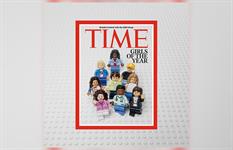In February, Lego Group released its F1-themed collection of buildable Ferrari, McLaren and Mercedes race cars and accompanying racers sporting helmets and branded race gear.
Today, the Denmark-based toy brand shifted gears by designing a figurine not inspired by F1 racers Lando Norris or Lewis Hamilton, but by 17-year-old racing driver Ivanna Richards. She was 4 years old when she first rode around a racetrack at 160 miles an hour, and was the first Mexican young woman invited to drive in the F1 Academy — a racing series encouraging girls to participate in the male-dominated sport.
Richards, along with nine others, was honored on Time magazine’s first Girls of the Year list this morning. The list, which builds on the Time Women of the Year tradition and celebrates young women “turning imagination into impact,” aligns with Lego Group’s She Built That campaign, which launched in June, according to Lego Group chief product and marketing officer Julia Goldin.
“Children are incredibly observant,” Goldin told Campaign. “They notice who gets celebrated, who’s missing and what stories are being told. As a brand that’s part of many children’s daily lives, we have a responsibility to reflect the world as it could be — not just as it is.”
While Time’s Women of the Year magazine covers often host editorial-style, sometimes black-and-white photographs of women in suits, today’s Girls of the Year front page displays 10 Lego figurines designed by Lego and Time Studios to “capture the spirit” of each honoree’s achievements.
The Lego figurine representing Defne Özcan, a 17-year-old pilot from Turkey, wears aviation goggles. The figurine for Rutendo Shadaya, a 17-year-old author of two published fantasy books, wears a Zimbabwean flag representing how her Zimbabwe-New Zealand roots inspire her writing. Lego’s representation of Naomi S. DeBerry, a 12-year-old author and advocate for organ donation inspired by her father’s kidney transplant journey, sports a stethoscope.
Bios for all the girls — who range from ages 12 to 17 — are available to read on Time’s website, along with a 30-second animation of each honoree in her element — in Lego form, of course. In the video, 15-year-old skateboarder Coco Yoshizawa, who competed in the Paris Olympics last summer, performs a flip trick. Zoé Clauzure, a 15-year-old French singer and anti-bullying advocate who began her musical career as a 10-year-old finalist on The Voice France, sings into a Lego microphone.
“Representation matters,” Goldin explained of the spot. “When girls don’t see themselves in roles like engineers, creators or inventors, they start to believe those spaces aren’t for them,” Goldin told Campaign, noting how the collaboration centers around building girls’ self esteem. “Society’s view of builders is still heavily influenced by gender stereotypes, and this is impacting the potential of girls later in life.”
Lego Group’s She Built That campaign, along with the company’s support of initiatives such as Lego Braille Bricks and audio instructions to support “visually impaired builders,” was inspired by company research revealing that 72% of parents feel girls lack female role models who “build” the world into a better place. Seventy percent of young women globally struggle to see themselves as someone good at “building something,” Goldin said.
“We hope this sparks imagination — that a girl sees one of the honorees and thinks, ‘maybe I can do something like that, too.’ Or a boy sees these stories and understands that builders come in every shape, background and gender,” Goldin explained. “For Time readers, many of whom are parents, educators or decision-makers, we hope this serves as a reminder of the importance of nurturing girls’ creativity, giving them platforms and removing barriers to their potential.”
The 102-year-old magazine, which reaches an audience of more than 120 million readers, named 15-year-old scientist Gitanjali Rao as its first Kid of the Year in 2020, recognizing her research on opioid addiction and contaminated water. Today’s launch of Girls of the Year pushes the needle towards celebrating girls such as Rao and landing more diverse innovators on the front page (even in Lego form).
Although Time and Lego cater to different audiences in terms of ages and interests, “the heart of the message is the same,” Goldin said. “Girls are builders — of ideas, movements, solutions and futures. Together, we wanted to make sure those stories were seen, celebrated and shared with the world.”
This story first appeared on Campaign US.
